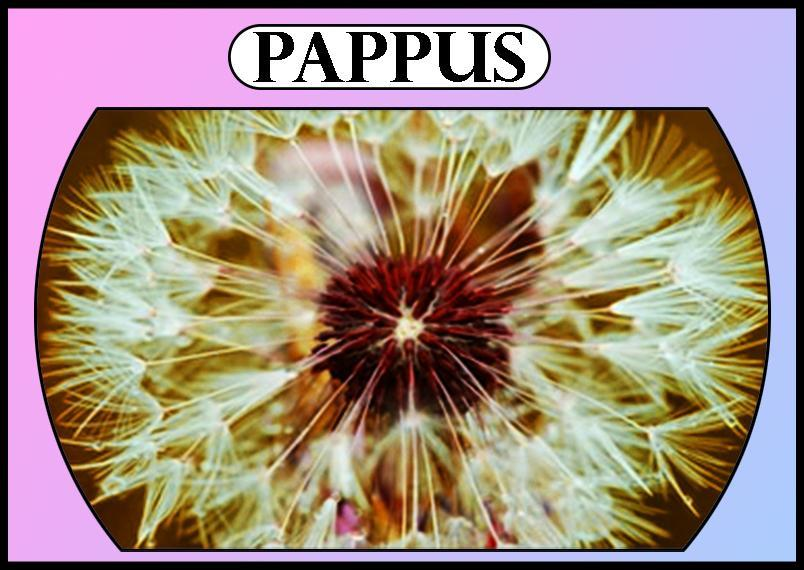
Pappus is modified
(a) Calyx
(b) Corolla
(c) Bracts
(d) Gynoecium
Answer
567.9k+ views
Hint: The pappus is the modified part of the part which is the outermost whorl of the parts of the flower, containing the sepals, which cover the petals as they grow and protect them.
Complete step by step answer:
The base of the corolla tube in the flower heads of the Asteraceae plant family, part of an individual floret is the calyx, which is called the modified pappus. The term is often used in other plant families, such as Asclepiadaceae, whose seeds are attached to a similar structure, even though it is not connected to the flower calyx.
- The outermost whorl of the sepals covers and protects the petals as they grow. A sepal is part of the flower of an angiosperm (flowering plant) . The protection for the budding flower, and support for the petals when they are in bloom are the important function of sepals.
- The calyx that withers or becomes vestigial is no longer used by most plants after flowering. As a protection for the fruit or seeds, some plants maintain a thorny calyx. Examples include the Acaena genus.

- The calyx not only survives after flowering in some plants but starts to grow instead of withering until it forms a bladder- like enclosure around the fruit. This offers effective defense against many forms of insects and birds, such as Hibiscus trionum and the Cape gooseberry. The calyx transforms into an accessory fruit in other species.
- Morphologically, all sepals and petals are leaves that are modified. The outer sterile whorls of the flower, which together form what is known as the perianth, are the calyx (the sepals) and the corolla (the petals) . Among flowering plants, the development and shape of the sepals differ considerably. They may be free (polysepalous) or fused (gamosepalous) .
So, the correct answer is, ‘Calyx’.
Note: The dandelion pappus has been researched and replicated for a number of uses. It has the ability to maintain around 100 times its weight in water and mechanisms inspired by pappus have been proposed and manufactured to allow highly efficient and specialized liquid transport. The use of minute airflow detection around walls is another application of the pappus, which is necessary to measure small variations in airflow in neonatal incubators or to measure low airflow velocity in heating and ventilation systems.
Complete step by step answer:
The base of the corolla tube in the flower heads of the Asteraceae plant family, part of an individual floret is the calyx, which is called the modified pappus. The term is often used in other plant families, such as Asclepiadaceae, whose seeds are attached to a similar structure, even though it is not connected to the flower calyx.
- The outermost whorl of the sepals covers and protects the petals as they grow. A sepal is part of the flower of an angiosperm (flowering plant) . The protection for the budding flower, and support for the petals when they are in bloom are the important function of sepals.
- The calyx that withers or becomes vestigial is no longer used by most plants after flowering. As a protection for the fruit or seeds, some plants maintain a thorny calyx. Examples include the Acaena genus.

- The calyx not only survives after flowering in some plants but starts to grow instead of withering until it forms a bladder- like enclosure around the fruit. This offers effective defense against many forms of insects and birds, such as Hibiscus trionum and the Cape gooseberry. The calyx transforms into an accessory fruit in other species.
- Morphologically, all sepals and petals are leaves that are modified. The outer sterile whorls of the flower, which together form what is known as the perianth, are the calyx (the sepals) and the corolla (the petals) . Among flowering plants, the development and shape of the sepals differ considerably. They may be free (polysepalous) or fused (gamosepalous) .
So, the correct answer is, ‘Calyx’.
Note: The dandelion pappus has been researched and replicated for a number of uses. It has the ability to maintain around 100 times its weight in water and mechanisms inspired by pappus have been proposed and manufactured to allow highly efficient and specialized liquid transport. The use of minute airflow detection around walls is another application of the pappus, which is necessary to measure small variations in airflow in neonatal incubators or to measure low airflow velocity in heating and ventilation systems.
Recently Updated Pages
Master Class 12 Business Studies: Engaging Questions & Answers for Success

Master Class 12 Economics: Engaging Questions & Answers for Success

Master Class 12 English: Engaging Questions & Answers for Success

Master Class 12 Maths: Engaging Questions & Answers for Success

Master Class 12 Social Science: Engaging Questions & Answers for Success

Master Class 12 Chemistry: Engaging Questions & Answers for Success

Trending doubts
Which animal has three hearts class 11 biology CBSE

1 Quintal is equal to a 110 kg b 10 kg c 100kg d 1000 class 11 physics CBSE

Explain zero factorial class 11 maths CBSE

The camels hump is made of which tissues a Skeletal class 11 biology CBSE

How do I convert ms to kmh Give an example class 11 physics CBSE

The percentage of free SO3 in oleum sample which is class 11 chemistry CBSE




